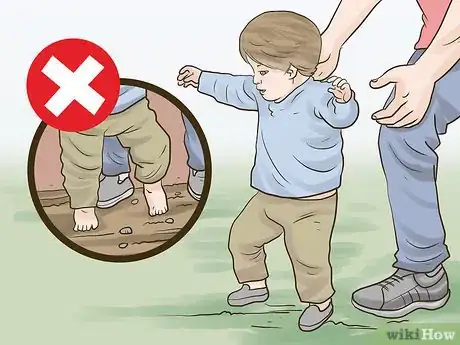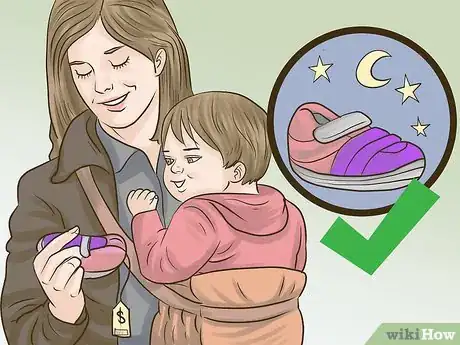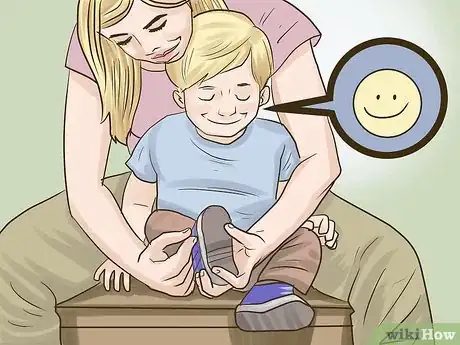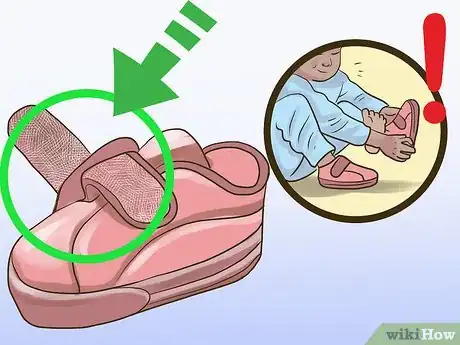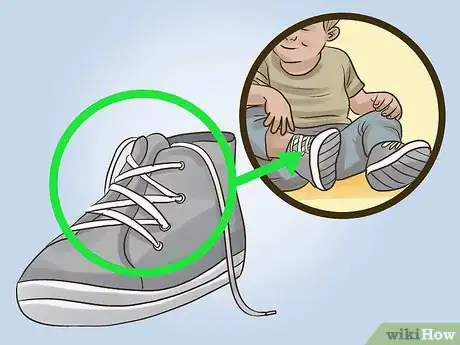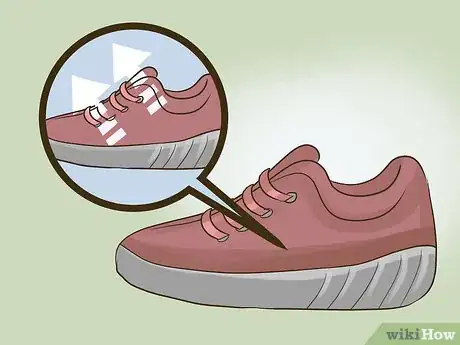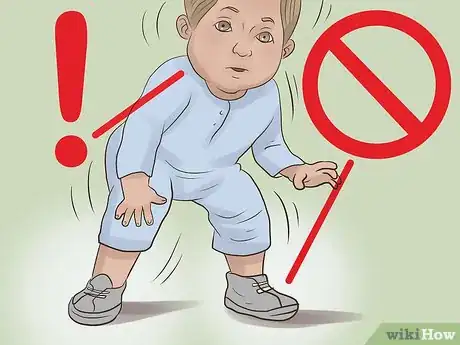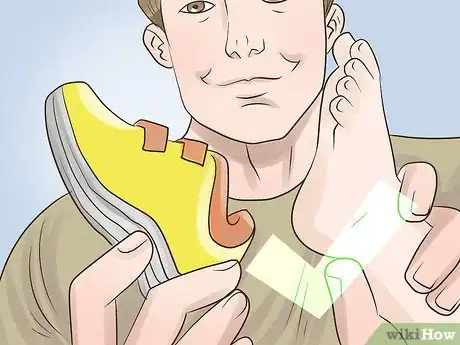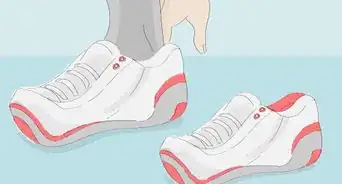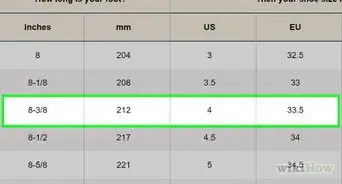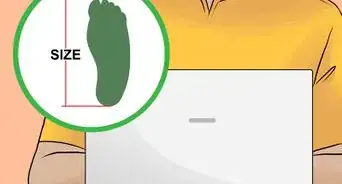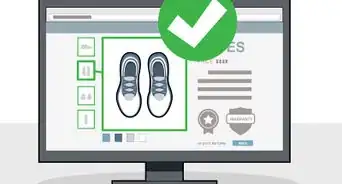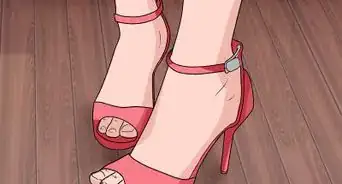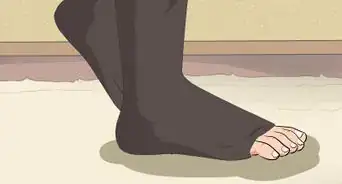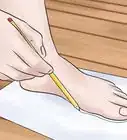X
This article was co-authored by wikiHow Staff. Our trained team of editors and researchers validate articles for accuracy and comprehensiveness. wikiHow's Content Management Team carefully monitors the work from our editorial staff to ensure that each article is backed by trusted research and meets our high quality standards.
This article has been viewed 17,611 times.
Learn more...
If your little bundle of joy is ready to start walking, you need to figure out what's important when picking out baby shoes. By shopping at the right time, choosing the right kind of shoes, and knowing how to ensure the proper fit, you'll have your little one up and running in no time!
Steps
Part 1
Part 1 of 3:
Deciding When to Shop
-
1Buy shoes when your baby starts taking steps. Infants don’t need shoes, because you’re always carrying them everywhere. But once your baby officially starts learning to walk, it’s a good idea to have at least one pair of shoes on hand to provide protection from dirt, germs, and dangerous objects.[1]
- It's fine to let your baby practice walking at home without shoes. It might even be easier for them to figure out how to balance out those first wobbly steps when they are barefoot.
- It may be dangerous for your baby to go barefoot outside. Never let your baby walk barefoot in parks, on pavement, or on rocky ground where their feet might get scratched or cut.
-
2Shop in the evening. Just like adult feet, baby feet can swell. Since your baby's feet are often bigger at the end of the day than in the morning or afternoon, you may want to wait until later on in the day to shop. Shoes that fit just fine in the morning may be too tight in the evening.[2]Advertisement
-
3Shop when your baby is in a good mood. The last thing you want is for your adorable little shoe shopper to be tired and crabby. Your baby will need to walk around while trying on new footwear, so try to plan around naps and meals. A hungry, grumpy baby is not going to be interested in trying on shoes (and you don’t want to try to put shoes on feet that are kicking mad!)
Advertisement
Part 2
Part 2 of 3:
Choosing a Pair of Shoes
-
1Choose shoes with Velcro fasteners for quick removal. Velcro can make getting your baby’s shoes on and off a breeze, and you won’t have to worry about constantly retying loose laces. Keep in mind that Velcro is pretty easy to figure out, though. Once your baby figures out how to work the Velcro, you might be in for some trouble! Babies love to take their shoes off when they probably shouldn’t![3]
-
2Choose shoes with laces to make sure they stay put. If you decide to go with lace-up shoes instead, make sure that you get some with laces that are long enough to double knot. Otherwise, you’ll be spending a lot of time tying and retying. Lace-up shoes are harder for babies to take off, so you may save some time that you might have spent looking for lost shoes.
-
3Choose slip-on shoes to save time during the on and off process. If you decide against Velcro and lace-up shoes, you may want to try a slip-on shoe. While slip-ons definitely save time during the on and off process, they do have some drawbacks. Slip-on shoes are harder to fit correctly when you change the thickness of your baby’s socks. They also may be easy for your baby to remove and you may end up with a lost shoe.
-
4Choose shoes with a flexible, soft sole. Baby shoes should be soft. They should also have very bendable, flexible soles so that your baby can use those cute little feet properly to gain balance. Since babies learn by touching and feeling things, your baby will need to be able to feel the ground through the shoes. Robeez and Pedipeds are good brands for a first shoe for babies and they fit even the chubbiest of baby feet.[4]
-
5Choose shoes with non-skid bottoms. It’s hard enough to learn to walk without sliding around all over the place! Your baby will need good traction. Make sure that the shoes you choose for your baby are non-skid, but not too thick that they can’t bend their feet properly. Soles with rubber grip are a good idea, especially if your baby will be walking on slippery floors.
-
6Choose a light, breathable material. Baby feet sweat more than you would think! You would be unpleasantly surprised at how yucky those sweet baby feet can smell after being stuck inside of sweaty shoes all day! Make sure the material you choose is breathable so your baby's foot won't get hot and uncomfortable (and stinky).[5]
- Look for shoes made from soft leather, canvas, or another breathable material. Soft leather or cloth is best.
- Avoid shoes made from stiff leather. Shoes that are too stiff can hinder the development of your baby’s feet.
- If you choose high-tops or boots, make sure that they are still flexible around the ankles. You don’t want the shoes to restrict movement.
- Avoid synthetic materials. While they may be light, they aren’t breathable.
Advertisement
Part 3
Part 3 of 3:
Ensuring a Proper Fit
-
1Try them on for size. It’s important for your baby to try on the shoes you choose. Put the shoe on your baby’s foot and assess the situation. If the shoes are too small, your baby’s feet will be cramped, but shoes that are too big can cause tripping and you don’t want that. Learning to walk is hard enough already!
- Your baby’s toes should be close to the end of the shoes but they shouldn’t be crowded at the end.
- When your baby stands up, there should be a tiny bit of room between your baby’s heel and the heel of the shoe.
- There should be a thumbs-width between your baby’s big toe and the front of the shoe.
-
2Do the squeeze test. If the shoe you choose is made from a softer fabric, put the shoe on your child’s foot and then try to pinch some of the material between your fingers. If you are unable to gather any material, the shoes are probably too tight. The shoe should have a little bit of wiggle room, but not too much.
-
3Look for signs of discomfort. Baby shoes should never need to be “broken in.” Let your baby walk around in the shoes for a while when you are still in the store. Tripping or limping indicate discomfort. Does your baby move normally, or do the shoes seem to hinder movement? When you take the shoes off, look for any red spots or irritated areas on your baby’s feet. If you find any, you may want to try another pair.
-
4Check the fit often. All babies grow at different rates, but their feet often grow really fast! Some babies may have growth spurts that will require new shoes sooner than you would think. Check your baby’s shoes often to make sure their toes aren’t squished and that there’s ample room for their little feet to grow.[6]
Advertisement
References
- ↑ http://day2dayparenting.com/should-babies-wear-shoes/
- ↑ http://orthoinfo.aaos.org/topic.cfm?topic=a00143
- ↑ https://www.whattoexpect.com/baby-products/baby-care/best-baby-shoes/
- ↑ https://www.babble.com/products/baby-shoes-toddler-new-walkers-2/
- ↑ http://www.aofas.org/footcaremd/how-to/footwear/Pages/How-to-Select-Children's-Shoes.aspx
- ↑ https://www.thespruce.com/buying-babys-first-shoes-293782
About This Article
Advertisement
